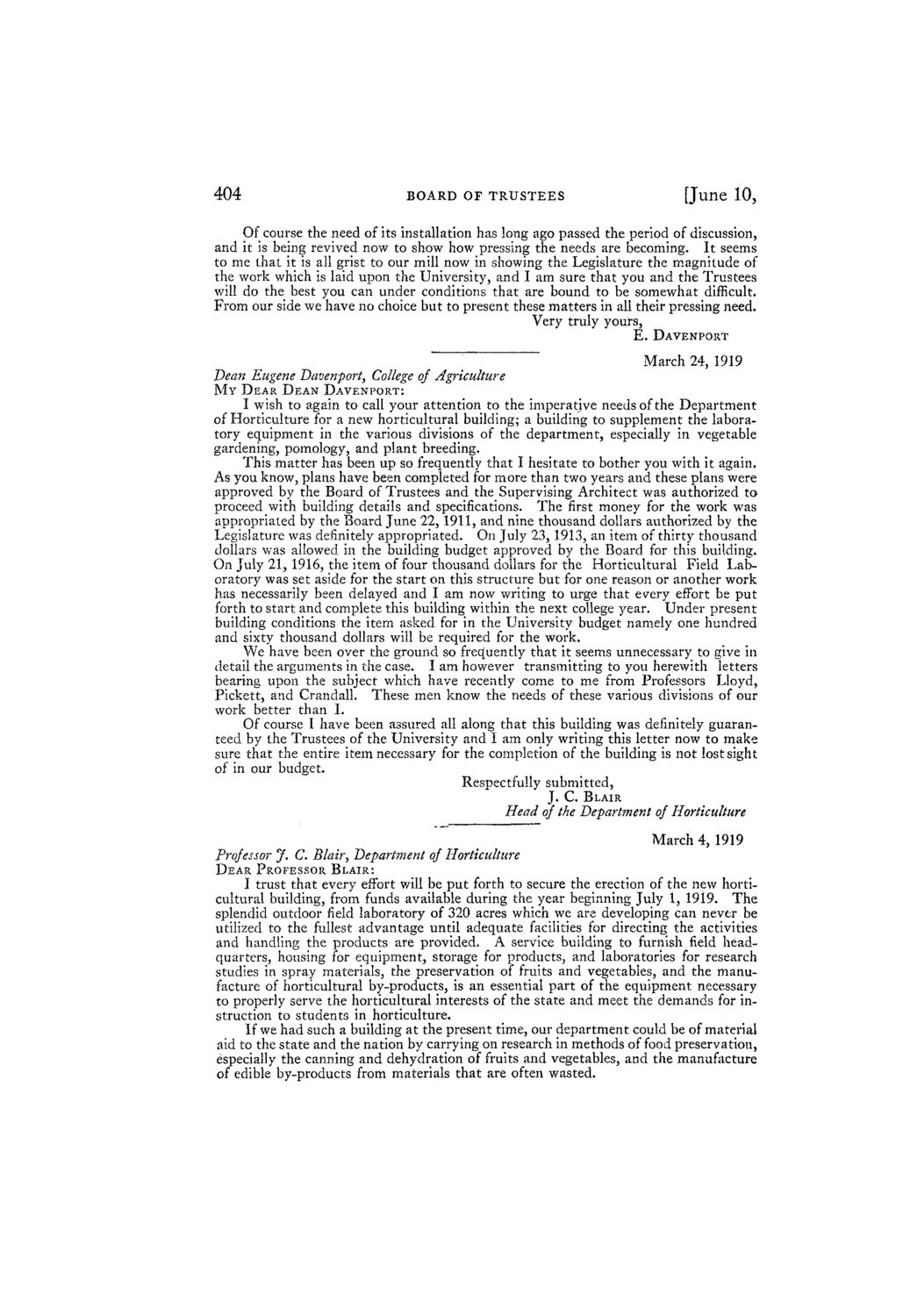| |
| |
Caption: Board of Trustees Minutes - 1920
This is a reduced-resolution page image for fast online browsing.

EXTRACTED TEXT FROM PAGE:
404 BOARD OF TRUSTEES [June 10, Of course the need of its installation has long ago passed the period of discussion, and it is being revived now to show how pressing the needs are becoming. It seems to me that it is all grist to our mill now in showing the Legislature the magnitude of the work which is laid upon the University, and I am sure that you and the Trustees will do the best you can under conditions that are bound to be somewhat difficult. From our side we have no choice but to present these matters in all their pressing need. Very truly yours, E. DAVENPORT March 24, 1919 Dean Eugene Davenport, College of Agriculture M Y DEAR DEAN DAVENPORT: I wish to again to call your attention to the imperative needs of the Department of Horticulture for a new horticultural building; a building to supplement the laboratory equipment in the various divisions of the department, especially in vegetable gardening, pomology, and plant breeding. This matter has been up so frequently that I hesitate to bother you with it again. As you know, plans have been completed for more than two years and these plans were approved by the Board of Trustees and the Supervising Architect was authorized to proceed with building details and specifications. The first money for the work was appropriated by the Board June 22, 1911, and nine thousand dollars authorized by the Legislature was definitely appropriated. On July 23, 1913, an item of thirty thousand dollars was allowed in the building budget approved by the Board for this building. On July 21, 1916, the item of four thousand dollars for the Horticultural Field Laboratory was set aside for the start on this structure but for one reason or another work has necessarily been delayed and I am now writing to urge that e^ery effort be put forth to start and complete this building within the next college year. Under present building conditions the item asked for in the University budget namely one hundred and sixty thousand dollars will be required for the work. We have been over the ground so frequently that it seems unnecessary to give in detail the arguments in the case. I am however transmitting to you herewith letters bearing upon the subject which have recently come to me from Professors Lloyd, Pickett, and Crandall. These men know the needs of these various divisions of our work better than I. Of course I have been assured all along that this building was definitely guaranteed by the Trustees of the University and I am only writing this letter now to make sure that the entire item necessary for the completion of the building is not lost sight of in our budget. Respectfully submitted, J. C. BLAIR Head of the Department of Horticulture March 4, 1919 Professor J. C. Blair, Department of Horticulture DEAR PROFESSOR BLAIR: I trust that every effort will be put forth to secure the erection of the new horticultural building, from funds available during the year beginning July 1, 19i9. The splendid outdoor field laboratory of 320 acres which we are developing can never be utilized to the fullest advantage until adequate facilities for directing the activities and handling the products are provided. A service building to furnish field headquarters, housing for equipment, storage for products, and laboratories for research studies in spray materials, the preservation of fruits and vegetables, and the manufacture of horticultural by-products, is an essential part of the equipment necessary to properly serve the horticultural interests of the state and meet the demands for instruction to students in horticulture. If we had such a building at the present time, our department could be of material aid to the state and the nation by carrying on research in methods of food preservation, especially the canning and dehydration of fruits and vegetables, and the manufacture of edible by-products from materials that are often wasted.
| |